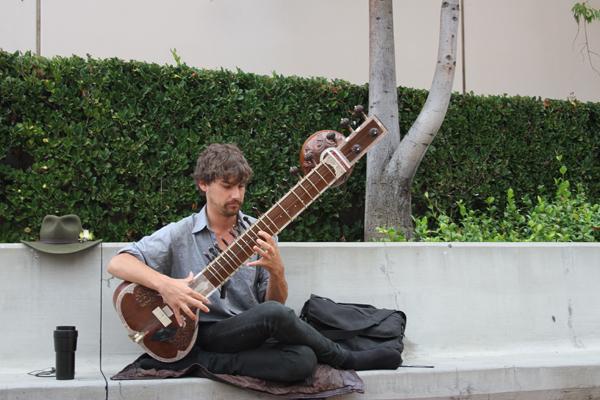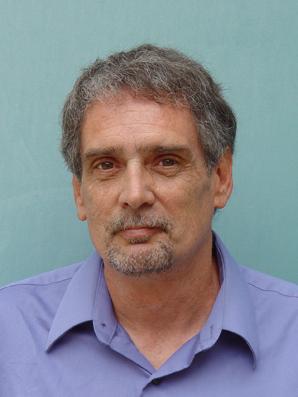Aspiring Musician Brings Indian Classics to Campus

SOUNDS OF INDIA: Evan Hatfield performs on the sitar.
Many students may have passed by a musician playing a strange instrument in front of the San Gabriel building this semester.
Evan Hatfield, a 23-year-old music major, lugs his sitar around campus, playing regularly in front of the student body. A sitar is a stringed instrument that has a very distinct sound that evokes feelings of a different place. Much like the bagpipes of Scotland or the shamisen of Japan are identified with specific countries, the sitar is uniquely Indian.
A sitar looks similar to a banjo but with a wider, longer neck and a rounder body. Its bridge holds 18-21 strings, of which only six or seven are played, and the rest serves to resonate the sound. Some sitars also have a second resonating chamber attached at the top of its neck, in addition to its main body.
Hatfield often practices outside, whether on campus or at Verdugo Park, which is located across the college.
“I met him the same way everyone else did. I saw him playing sitar his first semester, I just sat down next to him and I was like ‘we’re going to be friends’,” Jafet Vallejos, 25, talks about how he met Hatfield. “We both like music and we can relate on certain levels. We’re always showing each other music and going to shows. He’s the dude who is always dancing at a show.”
“It’s fun and you always see the people who are inherently curious of life,” Hatfield said.
This second-year student grew up in Visalia, an agricultural town in central California. His mother is a teacher and guitar player, who paid her way through college as a guitar instructor.
Hatfield grew up listening to classical music and learning about musicians’ lives.
“I remember going on road trips with my parents and they would have these cassette tapes of life stories of famous composers, like Tchaikovsky and Beethoven,” Hatfield said.
He learned to play instruments at a young age. At around 6 years old, his mom made him take piano lessons and he hated it. But he discovered a penchant for the saxophone and at 10 he played in the school band. Eventually, his mother found him a saxophone teacher, but then he did not like it as much anymore. He also picked up a guitar at the age of 12, when he thought it would look “cool.”
“I always remember liking music,” he said, as he recalled how he got into playing all these instruments. “But I got more into improvising because it was so contradicting to the lessons I’d had when I was younger, where I would come in and have a sheet of music and I’d have to play it exactly like it’s written and there’s just so many rules.”
He was a high school student when his grandparents gifted him with a sitar from one of their travels to India. He took his guitar knowledge and tried to translate it into sitar. A year or two out of high school and indecisive about what he wanted to do with his life, he met his guru, Paul Livingstone.
He was living in Ojai, playing gigs for a living, when a musician friend urged him to watch one of Livingstone’s shows. Hatfield saw him play and realized that his knowledge of sitar playing was virtually non-existent.
A couple of weeks after that, he found himself in Livingstone’s house having his first lesson.
“It was very intense. He would have me play something very simple over and over again until I could do it without thinking about it,” Hatfield said.
The lessons continued for about a year, most of which were done through Skype, when his mentor offered him a place in a RV parked in the driveway of his Altadena home.
In January 2015, Hatfield’s four-month training began with his teacher knocking on the door at 7 a.m. for their two-hour morning lessons. He also had extensive two-hour lessons at night with practices in between.
“It is only by studying within the traditional context that you’ll get the proper sound on sitar,” Livingstone said. “It’s a very difficult instrument. It takes many years of discipline, training, and practice.”
Hatfield describes the experience as grueling, recalling the first few days when his fingers were so numb and tired from playing.
“It wasn’t until the very end that I started to realize, I just learned three years worth of Indian music in four months, and I’m healthier and happier than I’ve ever been,” Hatfield said. “It was just such an enlightening experience.”
When his training ended, his mentor’s wife encouraged him to go back to school. He decided to look around GCC where his mentor’s wife takes arts classes and he fell in love with the campus. He approached the music department and asked if sitar could be his primary instrument for the applied music program. At that time, sitar is not part of the school’s program.
“He’s [Hatfield] very driven about doing what he wants to do, and very intense about it. And he’s always looking around for opportunities to grow,” said Beth Pflueger, music instructor and organizer of GCC’s applied music program. “Partly due to him, we started offering sitar as part of our applied music program. We hadn’t done any Indian music instruments until now.”
Dr. Paul Sherman, one of the school’s music instructor who specializes in world music, decided to take on the project of starting a North Indian music program. He invited Paul Livingstone to teach Indian music in the school, and he agreed.
The college currently offers introductory and advanced classes for an Indian music ensemble. The language of Indian music class is the introductory performance ensemble that teaches the fundamentals of how to understand the music and sing in the system of music, which is based on raga and tala.
The Indian music ensemble is an advanced class that tackles traditionally arranged ragas and some crossover with chamber music and jazz. It is an Indian ensemble with east to west instrumentation that includes the guitar, flute, sitar, tabla, tanpura and sarangi.
Hatfield plans to transfer to Cal Arts after he finishes his associate’s degree. Eventually, he wants to work in music production. He loves improvising and creating his own music, a mix of traditional Indian music and electronica. He confided the purpose behind his passion:
“Music is something that can take you really deep inside yourself or bring you out of yourself and look at life in a different way,” he said. “There are people who are in their own bubble and they’re very comfortable there and I just want people to get out of their minds.”

Diane Roxas was born and raised in the Philippines. She was studying for a Bachelor of Arts degree in journalism at the University of Philippines-Diliman...

Sal Polcino is a professional jazz guitarist and published songwriter. Since coming to Glendale College he has been published in the Glendale News-Press...
